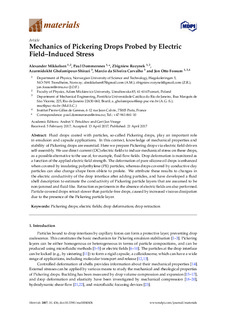| dc.contributor.author | mikkelsen, alexander | |
| dc.contributor.author | Dommersnes, Paul Gunnar | |
| dc.contributor.author | Rozynek, Zbigniew Jerzy | |
| dc.contributor.author | Gholamipour-Shiraz, Azarmidokht | |
| dc.contributor.author | Carvalho, Marcio | |
| dc.contributor.author | Fossum, Jon Otto | |
| dc.date.accessioned | 2017-08-22T07:24:31Z | |
| dc.date.available | 2017-08-22T07:24:31Z | |
| dc.date.created | 2017-06-23T13:27:53Z | |
| dc.date.issued | 2017 | |
| dc.identifier.citation | Materials. 2017, 10 436-?. | nb_NO |
| dc.identifier.issn | 1996-1944 | |
| dc.identifier.uri | http://hdl.handle.net/11250/2451349 | |
| dc.description.abstract | Fluid drops coated with particles, so-called Pickering drops, play an important role in emulsion and capsule applications. In this context, knowledge of mechanical properties and stability of Pickering drops are essential. Here we prepare Pickering drops via electric field-driven self-assembly. We use direct current (DC) electric fields to induce mechanical stress on these drops, as a possible alternative to the use of, for example, fluid flow fields. Drop deformation is monitored as a function of the applied electric field strength. The deformation of pure silicone oil drops is enhanced when covered by insulating polyethylene (PE) particles, whereas drops covered by conductive clay particles can also change shape from oblate to prolate. We attribute these results to changes in the electric conductivity of the drop interface after adding particles, and have developed a fluid shell description to estimate the conductivity of Pickering particle layers that are assumed to be non-jammed and fluid-like. Retraction experiments in the absence of electric fields are also performed. Particle-covered drops retract slower than particle-free drops, caused by increased viscous dissipation due to the presence of the Pickering particle layer. | nb_NO |
| dc.language.iso | eng | nb_NO |
| dc.publisher | MDPI | nb_NO |
| dc.rights | Navngivelse 4.0 Internasjonal | * |
| dc.rights.uri | http://creativecommons.org/licenses/by/4.0/deed.no | * |
| dc.title | Mechanics of Pickering Drops Probed by Electric Field Induced Stress | nb_NO |
| dc.type | Journal article | nb_NO |
| dc.type | Peer reviewed | nb_NO |
| dc.description.version | publishedVersion | nb_NO |
| dc.source.pagenumber | 436-? | nb_NO |
| dc.source.volume | 10 | nb_NO |
| dc.source.journal | Materials | nb_NO |
| dc.identifier.doi | 10.3390/ma10040436 | |
| dc.identifier.cristin | 1478526 | |
| dc.description.localcode | ©2017 by the authors. Licensee MDPI, Basel, Switzerland. This article is an open accessarticle distributed under the terms and conditions of the Creative Commons Attribution(CC BY) license (http://creativecommons.org/licenses/by/4.0/). | nb_NO |
| cristin.unitcode | 194,63,35,0 | |
| cristin.unitcode | 194,66,20,0 | |
| cristin.unitname | Institutt for elektronikk og telekommunikasjon | |
| cristin.unitname | Institutt for fysikk | |
| cristin.ispublished | true | |
| cristin.fulltext | original | |
| cristin.qualitycode | 1 | |

